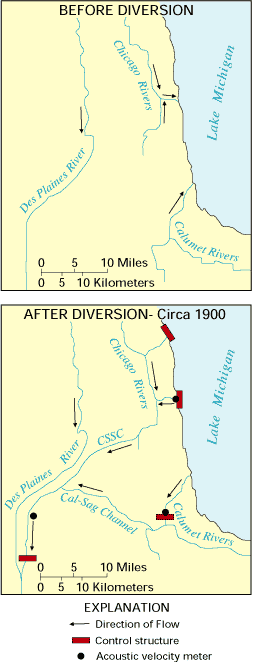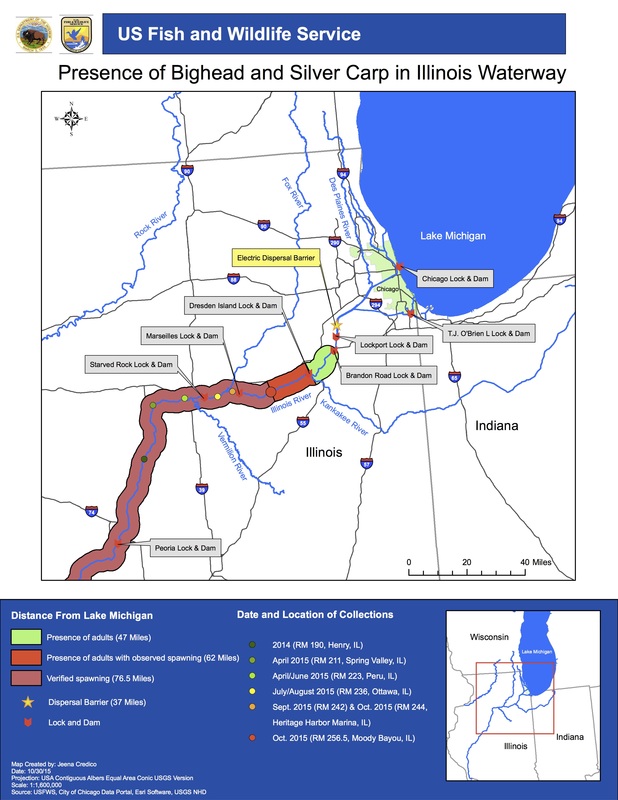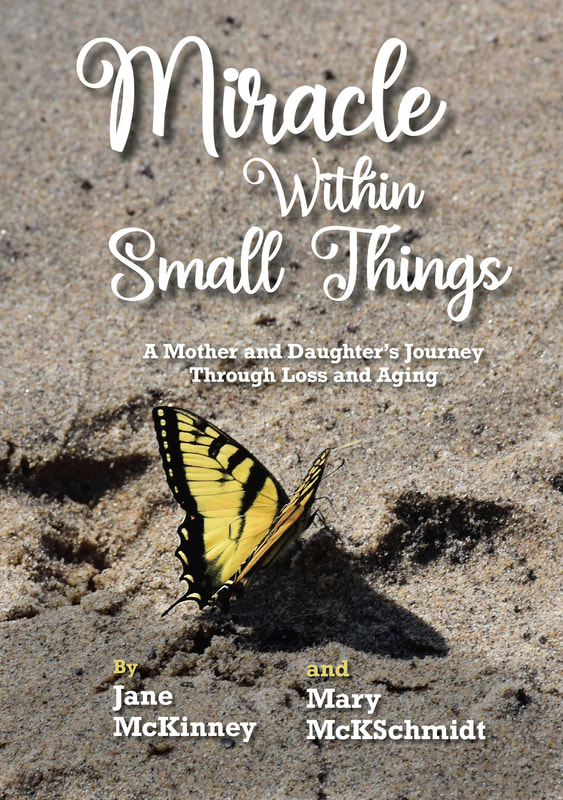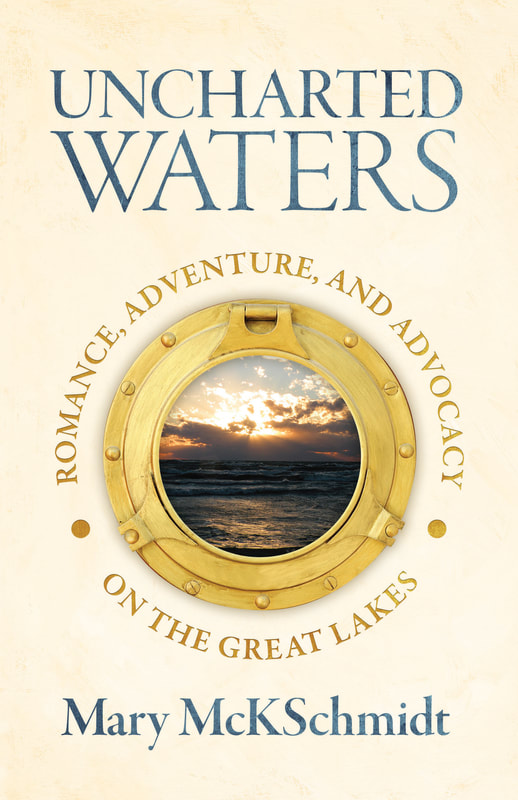of sunlight on the pooling water or notice the patterns drawn in the wet sand by a recoiling wave. Balance has never been my strong suit. I read about the juvenile Asian carp swimming 66 miles closer to Lake Michigan than previously recorded and I shudder. The US Fish and Wildlife Service says these little fish could hide in the underwater spaces between commercial barges, slipping through the electronic barriers designed to keep the carp out of Lake Michigan. I remember a hand clutching a jar of the greenish soup from Lake Erie; the photograph of trucks hauling away Wisconsin’s pristine sand for use in fracking; the video of the sixty-year-old oil pipeline lying untethered on the sandy floor of Lake Michigan one mile west of the Mackinac Bridge. I feel the unseasonably warm December temperatures and know Lake Superior will not receive the level of ice cover needed to keep our fresh water from evaporating, to keep our water levels high enough for commercial and recreational boaters to pass through our harbors. On and on I go . . . worrying. And so I now take a camera with me on my walks alongside Lake Michigan . . . and the bag for trash. I need both. Left brain and right brain. Facts and passion. Reality and hope. I do not cover much ground quickly. With this as an introduction, I share with you, those readers who asked for an update on the Asian carp, my latest findings. The Asian Carp Conundrum Photo from Wikipedia Photo from Wikipedia Can we keep the invasive Asian carp out of Lake Michigan? The young ones, the juveniles measuring 5-6 1/2 inches long, seem to be particularly problematic. Studies conducted this summer by the U.S. Fish and Wildlife Service indicate the small, juvenile fish could become trapped in the underwater spaces between commercial barges and inadvertently transported across the electronic barriers designed to keep the Asian carp from reaching Lake Michigan. And while the leading edge of the adult carp population has remained the same since 2006, in late October it was reported the juvenile silver carp population was in the Marseilles pool of the Illinois River, 66 miles closer to Lake Michigan than previously reported at the beginning of 2015. No one wants these prolific species of silver, bighead, black, and grass Asian carp with voracious appetites to invade the Great Lakes. The silver and bighead are particularly troublesome. They devour the plankton populations, the bottom of the food chain that sustains other fish populations. The silver species jump wildly out of the water at the humming of an approaching motor, injuring recreational boaters. Experts say the invasion of the Asian carp could decimate the $7 billion dollar Great Lakes’ fishing industry and the $16 billion recreational boating industry. But the solution is complicated by the newness of the science needed to monitor and deter movement of the fish as they swim up the Mississippi and Illinois Rivers towards Lake Michigan. It’s politicized by the diverse interests of those affected by possible solutions. And ultimately, the best answers could be derailed by the price tag. Time is working against us. Preventing the carp from reaching Lake Michigan depends on the speed of the Army Corps of Engineers in determining the feasibility of a new lock and dam system under design at the Brandon Road Lock & Dam, roughly 25 miles from the lake. They will not have answers until 2017. During the interim, the Asian Carp Regional Coordinating Committee is leading efforts across a multitude of agencies, organizations, and universities working diligently to outsmart the carp. Their success depends on the efficacy of the electronic barriers, water guns, harvesting efforts, carbon dioxide released at dam entrances, and an earthen berm in Indiana. It depends on their ability to use environmental DNA, electro-fishing, poison, and other techniques to monitor the movement of the fish. And it depends on the continued prioritization and funding of the efforts of the Army Corps of Engineers by Congress and the White House. Experts agree the only sure way to prevent the two-way exchange of aquatic invasive species from flowing between the Mississippi River and Lake Michigan is to reverse the decisions made over 100 years ago and return the natural divide that existed between the two basins. A study commissioned by the Great Lakes Commission and the Great Lakes and St. Lawrence Cities Initiative, demonstrated that full separation, also called hydrological separation, was a feasible and viable option. It is also very controversial. The Chicago Sanitary and Ship Canal, a 28-foot long and 160-foot-wide artificial canal, was built at the turn of the 20th century to flush Chicago’s sewage and industrial waste towards the Mississippi River rather than into Lake Michigan. The lake was, and remains, the source of the city’s drinking water. When thousands died of typhoid fever in the 1890’s, city leaders decided to reverse the flow of the Chicago and Calumet Rivers by creating the canal and connecting Lake Michigan to the Illinois River and, ultimately, the Mississippi. The canal also became an integral part of a complex waterway system that facilitates commercial barge traffic from Chicago to New Orleans. In the early 1900s, no one considered the possibility that the new water highway would one day become a conduit for aquatic invasive species to threaten natural ecosystems from New Orleans to the St. Lawrence Seaway. The decision had unintended consequences. So, too, did the decision made in the 1970s by Arkansas biologists who introduced the Asian carp into polluted ponds and lagoons as an alternative to using chemicals to filter and clean the water. Flooding, and the inadvertent release of the carp into the wild, began the carp’s destructive march up the Mississippi River. Ultimately, the recommendation for a long term solution rests on the shoulders of 32 individuals representing the diverse interests of all major stakeholders. I am told this group, the Chicago Area Waterway System Advisory Committee, hopes to hammer out their differences and reach a consensus by year-end. They must take into consideration the concerns of commercial navigation as well as that of the fishing and boating recreational industries. They must consider the effect of Lake Michigan’s water quality if sewage effluent from Chicago and contaminated sediment from their harbors flow freely into the lake. And as the locks are currently used to control flooding, they must work in concert with those implementing the Tunnel and Reservoir Plan (TARP), an elaborate system of tunnels and reservoirs designed to channel excess water and sewage away from downtown Chicago. Its targeted completion date is 2029. The Advisory Committee will make a recommendation, not a decision. Those we choose to represent us at the federal, state, and local levels of government will have the final say. And because there is no “they” in a democracy, the decision is on our shoulders. Can we move quickly enough to keep these carp out of our lakes? Additional Information
A special thanks to CAWS Advisory Committee members David Hamilton of The Nature Conservancy and David Ulrich of the Great Lakes and St. Lawrence Cities Initiative for taking the time and energy to update me on the Asian carp conundrum. While there is a plethora of information out there on the Asian carp, my favorites sites include the following. Double-click on the blue titles to link directly to the appropriate website:
7 Comments
Molly Laflin
12/15/2015 10:33:10 am
Wow. A balanced perspective is pretty tough on this one. Sadness is my reaction. We should not give up, but we need to enjoy the beauty of what we have now, because the future is at best uncertain. I admire and applaud those who are taking action. I need to remind myself of what you said a couple of days ago, Mary, "Worrying won't help."
Reply
Karen
12/15/2015 12:34:31 pm
"The inadvertent release of the carp into the wild"....wondering how that happened exactly. ERRR.
Reply
Eric Stemle
12/15/2015 03:38:36 pm
Intended or not, consequences are consequences, and the seemingly inexorable journey of the Asian carp toward Lake Michigan breaks my heart. I say "seemingly" because I know that we can find a way to prevent this catastrophe. The opening quotation for my class today is from Frank Gaines: "Only (s)he who can see the invisible can do the impossible." I believe that you can see the invisible, Mary. More importantly, I believe that you can help others see it as well. The Earth speaks through your words.
Reply
Mary Ellen Miller
12/15/2015 03:59:11 pm
The previous commenters have expressed my own thoughts and reactions, but done so in a way much more articulate than I could have managed. This situation seems overwhelming, but I am grateful for the people with passion who keep fighting the good fight. Thank you, Mary. May the New Year see some movement in a positive direction.
Reply
Grace
12/16/2015 10:54:26 am
I, like the other commenters, deeply appreciate the depth and breadth of your commitment to protect the Great Lakes. Yours is a compelling voice. Keep on dear Mary.
Reply
Barb Ferguson
12/16/2015 02:56:01 pm
Thank you for the update and for the resources for more information....as well as for the reminder to take a trash bag along when walking the beach. Your words inspire action!
Reply
12/31/2015 05:05:21 pm
One little fish. Most don't realize the power it has. The power to destroy a fishing industry, the power to reverse a 100-year-old- decision to open a waterway.
Reply
Leave a Reply. |
From briefcase to pen, paper and camera, one woman's journey to influence
how we care for the environment, our seniors, each other. Available
from your local bookstore or online retailer 
The Ideal Gift Tiny Treasures, a collection of wildflower photographs and poetic prose, available by contacting me. The 2nd Edition of Tiny Treasures is designed for use on PCs, tablets, and phones and is available at online stores. To learn more, click on the Ibook/Ebook button below:
|





 RSS Feed
RSS Feed
